- COMBATANT
- See ‘respectant’ in ‘appendix V’.
![[combatant example]](../images/v/vxt-d1062.gif)
Flag of Leuzigen, Switzerland (fotw)
- COMBINED (or COMBINATION) FLAG (or STANDARD)
- The term which may be used to describe a flag or flag-like image that is usually
intended to illustrate unity between those countries allied in an armed conflict – a
combination flag or standard – but see
‘patchwork flag 1)’
(also ‘linguistic flags 1)’).
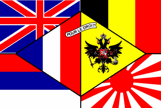
Flag showing the Allies in the Great War c1914 (Eugene Ipavec)
- COMMAND FLAG
- See ‘flag of command’.
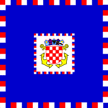
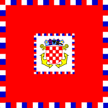
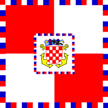



Command Flags/Flags of Command of an Admiral,
Vice Admiral and Rear-Admiral, Croatia (fotw);
Flag Officers of the Red, The White and The Blue, England 1625 - 1702.
- COMMAND PENNANT
- 1) In naval usage, a generally triangular and/or swallow-tailed pennant flown
at sea that, unlike a flag of command, broad pennant or burgee command pennant,
does not replace the masthead pennant but which signifies an officer in command
of other ships who is below the rank of commodore – a group command pennant, flotilla
command pennant, senior officer’s pennant, squadron command pennant and others
(see also ‘broad pennant’,
‘broad command pennant’,
‘burgee command pennant’,
‘flag of command’,
‘masthead pennant 1)’,
‘private ship’ and
‘senior officer afloat pennant’).
- 2) In US usage, the command pennant of a unit equivalent to the above but of aviation or marine forces.
![[collar]](../images/v/vxt-d095.gif)
From left; Squadron Command Pennants: UK (Graham Bartram); Denmark (fotw);
Flotilla Command Pennant: Netherland (CS)
Notes
a) With regard to 1) - not to be confused with the senior officer afloat
pennant which (certainly in the case NATO and related services, and of countries whose navy
bases its traditions on those of the RN) is only flown whilst alongside or in harbour.
b) A distinction has been drawn between the standard masthead pennant flown
by commissioned warships (occasionally called a pennant of command), and the command
pennants as defined above that are flown subordinate to it.
c)
Further to 1), in the former Austro-Hungarian Navy and in some others, the practice of
hoisting a command pennant with (or without) the hoist being stiffened by a frame was itself indicative of rank -
see ‘frame 2)’.

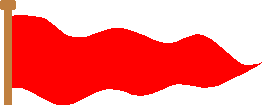
- COMMENDATION BANNER
- See ‘banner 5)’.
![[commendation banner example]](../images/v/vxt-d1357.gif)
C-in-C’s Commendation Banner, Canada (fotw)
- COMMENDATION FLAG (or PENNANT)
- See ‘award flag’.
![[commendation flag example]](../images/v/vxt-d1190.gif)
Navy Unit Commendation Pennant, US (Seaflags)
- COMMEMORATIVE FLAG
- A flag made to celebrate or to mark a particular occasion, such as an anniversary,
holiday or international congress - an event or occasional flag (see also ‘memorial flag’).
![[Queens golden jubliee flag]](../images/v/vxt-d567.gif)
![[17th International Congress of Vexillology]](../images/v/vxt-d567b.gif)
![[WW2 US commemorative flag]](../images/v/vxt-d2094.gif)
![[1876 centennial US flag]](../images/v/vxt-d567a.gif)
From left: Golden Jubilee of HM The Queen 2002, UK;
17th International
Congress of Vexillology, RSA (fotw); WWII Commemorative Flag, US (fotw);
Centennial Flag 1876, US;
- COMMEMORATIVE FLAG CASE
- See ‘flag case 2)’.
- COMMERCIAL CODE OF SIGNALS (or COMMERCIAL CODE OF SIGNAL FLAGS)
- The system which replaced Marryat’s code, and in use from 1866 – 1880 when it was superseded by the international code – see ‘International Code of Signal Flags’ and ‘Marryat's Code’.
![[commerical flag example]](../images/v/vxt-d2822a.gif)
![[commerical flag example]](../images/v/vxt-d2822b.gif)
![[commerical flag example]](../images/v/vxt-d2822c.gif)
![[commerical flag example]](../images/v/vxt-d2822d.gif)
MTLQ in the 1866 Commercial Code of Signals
- COMMERCIAL FLAG (or PENNANT)
- See ‘house flag 1)’ and
‘corporate flag’.
![[commerical flag example]](../images/v/vxt-d1191.gif)
![[commerical flag example]](../images/v/vxt-d2772.gif)
Flag of Associated Portland Cement Manufactures Ltd, UK (fotw); Pennant of the
Union Barge Line, US (fotw)
- COMMERCIAL LOGO
- See ‘logo’.
![[commerical flag example]](../images/v/vxt-d2773.gif)
Flag of McDonalds, Worldwide (fotw)
- COMMISSIONING or COMMISSION PENNANT
- See ‘masthead pennant 1)’. see supplemental
note
![[commissioning pennant]](../images/v/vxt-d482.gif)
Commissioning/Masthead Pennant,
Canada (fotw)
- COMMODORE’S BROAD PENNANT
- See ‘broad pennant 2)’.
![[commodore's broad pennant]](../images/v/vxt-d483.gif)
Commodore’s Broad Pennant, Pakistan (fotw)
- COMMON PENDANT (or PENNANT)
- In English then British RN usage, now obsolete, the commissioning or masthead pennant
with a split tricolour fly, and flown (together with a red ensign) between 1661 and c1850
by warships sailing under Admiralty orders - an ordinary, tricolour or
union pendant – see
‘masthead pennant 1)’ (also
‘man o'war pendant’ and
‘red ensign 2)’).
![[common pendant]](../images/v/vxt-d1279.gif)
The Common/Tricolour Pendant, England then UK 1661 – c1850 (fotw)
Please note that display of a common/tricolour pendent was a visual indication that the vessel wearing it was not subject to the authority of any local flag officer – see ‘distinction of colour’.
- COMPANY COLOURS (or COLORS)
- Small additional colours carried by foot regiments of the British and Canadian
Brigade of Guards, and a survival of the general 16th/17th Century practice of
carrying a colour for each company in a regiment – camp colours or silks (see
also ‘camp colour 1)’,
‘colour 2)’,
‘colours 2)’,
‘postures’,
‘stand of colours 1)’ and
‘venn’).
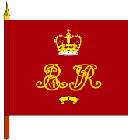

Company Colour, No 1 Company, 1st Battalion of The Irish Guards, UK (Graham Bartram); No 2 Company, Governor General’s Foot Guards, Canada (Official Website)
Please note that, while ten was the theoretic maximum, and six or seven the more usual, a regimental stand of nine colours
was not unknown for an English regiment of foot in the mid-17th Century.
- COMPANY FLAG
- See ‘corporate flag’.
![[company flag example]](../images/v/vxt-d1192.gif)
Flag of BOAC, UK (fotw)
- COMPARTMENT
- 1) In heraldry, the symbolic base upon which a shield and supporters may rest
in a full set of armorial bearings– but compare with ‘coupeau’
and ‘mount’ (see also
‘Appendix IV’,
‘armorial bearings’,
‘shield’ and
‘coat of arms’).
- 2) On flags see 'cartouche 2)'.
![[compartment example]](../images/v/vxt-d1258.gif)
Arms 1932 - 2000, South Africa (fotw)
- COMPLEMENT
- 1) In the International Code of Signals, two or more flags or pennants added
to a basic signal to give clarity or precision to the message (see also
‘international code of signal flags,
‘international code of signals’ and
‘signal flag’).
- 2) In heraldry a full moon – see ‘moon 2)’ with following note.
- COMPLETE (ARMORIAL) ACHIEVEMENT
- See ‘armorial bearings’.
![[Churchill arms]](../images/v/vxt-d890.gif)
Complete Armorial Achievement/Armorial Bearings of the Late Sir Winston Churchill, UK (Churchill Society)
- COMPLIMENTARY FLAG
- See ‘courtesy flag’.
- COMPONY
- The heraldic term used when an ordinary or a border is composed of squares (or occasionally
rectangles) in alternating tinctures – gobony, gobone or gobonated (see also
‘counter-compony’,
‘ordinary’ and
‘tincture’).
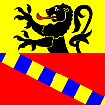
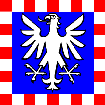
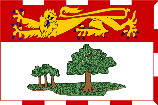
Flag of Estévenens, Switzerland (fotw); Flag of Tegerfelden,
Switzerland (fotw); Flag of Prince Edward Island, Canada (fotw)
- COMPONY COUNTER-COMPONY
- See ‘counter-compony’.
![[combatant example]](../images/v/vxt-d1063.gif)
Flag of Zeihen, Switzerland (fotw)
![[combatant example]](../images/v/vxt-d1062.gif)







![[collar]](../images/v/vxt-d095.gif)
![[commendation banner example]](../images/v/vxt-d1357.gif)
![[commendation flag example]](../images/v/vxt-d1190.gif)
![[Queens golden jubliee flag]](../images/v/vxt-d567.gif)
![[17th International Congress of Vexillology]](../images/v/vxt-d567b.gif)
![[WW2 US commemorative flag]](../images/v/vxt-d2094.gif)
![[1876 centennial US flag]](../images/v/vxt-d567a.gif)
![[commerical flag example]](../images/v/vxt-d1191.gif)
![[commerical flag example]](../images/v/vxt-d2772.gif)
![[commerical flag example]](../images/v/vxt-d2773.gif)
![[commissioning pennant]](../images/v/vxt-d482.gif)
![[commodore's broad pennant]](../images/v/vxt-d483.gif)
![[common pendant]](../images/v/vxt-d1279.gif)


![[company flag example]](../images/v/vxt-d1192.gif)
![[compartment example]](../images/v/vxt-d1258.gif)
![[Churchill arms]](../images/v/vxt-d890.gif)



![[combatant example]](../images/v/vxt-d1063.gif)



![[commerical flag example]](../images/v/vxt-d2822a.gif)
![[commerical flag example]](../images/v/vxt-d2822b.gif)
![[commerical flag example]](../images/v/vxt-d2822c.gif)
![[commerical flag example]](../images/v/vxt-d2822d.gif)